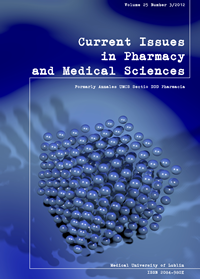Radiolabeling and biodistribution of new acetylcholinesterase inhibitor – 6-Hydrazino-N-[5-(2,3-dihydro-1H-cyclopenta[b]quinolin-9-ylamino)pentyl]nicotinamide hydrochloride
DOI:
https://doi.org/10.12923/j.2084-980X/25.3/a.16Słowa kluczowe:
potential PET marker, radiolabelling, technetiumAbstrakt
Nowadays research concerning new strategies for earlier diagnosis is among the most active areas in Alzheimer's science. Brain imaging techniques are among the most promising areas of research focused on early detection of Alzheimer’s disease (AD). In the present study we describe radiolabeling of a novel acetylcholinesterase inhibitor 6-hydrazino-N-[5-(2,3-dihydro-1H-cyclopenta[b]quinolin-9-ylamino)pentyl]nicotinamide (5C-5) with 99m-Technetium (99mTc). Biodistribution study of compound 5C-5 radiolabeled with 99mTc after intravenous administration to rats was also performed. According to biodistribution study 99mTc-radioactivity was mainly localized in the liver, partly also in the kidney, lung and gastrointestinal tract. Furthermore, compound under study revealed comparatively rapid blood radioactivity clearance.
Bibliografia
1. Abrams M.J. et al.: Technetium-99-m-Human Polyclonal IgG radiolabeled via the hydrazino nicotinamide derivative for imaging focal sites of infection in rats. J. Nucl. Med., 31, 2022-2028, 1990.
2. Brown-Proctor C. et al.: Synthesis and evaluation of 6-[11C]methoxy-3-[2-[1-(phenylmethyl)-4-piperidinyl] ethyl]-1,2-benzisoxazole as an in vivo radioligand for acetylcholinesterase. Nucl. Med. Biol. 26, 99-103, 1999.
3. Choe Y.S. et al.: Syntheses and biological evaluation of 18F-labeled 3-(1-benzylpiperidin-4-yl)-1-(1-methyl-1H-indol-3-yl)propan-1-ones for in vivo mappingof acetylcholinesterase. Nucl. Med. Biol. 27, 263–267, 2003.
4. Lee S.Y. et al.: Synthesis and Biological Evaluation of 1-(4-[18F]Fluorobenzyl)-4-
[(5,6-dimethoxy-1-oxoindan-2-yl)methyl]piperidine for in Vivo Studies of Acetylcholinesterase. Nucl.Med.Biol., 27, 741–744, 2000.
5. Liu S., Edwards D.S.: 99mTc-labeled small peptides as diagnostic radiopharmaceuticals. Chem. Rev., 99, 2235-2268, 1999.
6. Paes F.M. et al.: Radiopharmaceuticals: When and How to Use Them to Treat Metastatic Bone Pain. J. Support. Oncol., 9, 197–205, 2011.
7. Pandit-Taskar N., Batraki M., Divgi C.R.: Radiopharmaceutical Therapy for Palliation of Bone Pain from Osseous Metastases. J. Nucl. Med., 45, 1358-1365, 2004.
8. Pappata S. et al.: In vivo imaging of human cerebral acetylcholinesterase. J. Neurochem., 67, 876– 879, 1996.
9. Petrella J.R., Coleman E., Doraiswamy M.P.: Neuroimaging and Early Diagnosis of Alzheimer Disease: A Look to the Future. Radiology, 226, 315–336, 2003.
10. Reiman E.M., Jagust W.J.: Brain imaging in the study of Alzheimer's disease. NeuroImage, 61, 505–516, 2012.
11. Szymański P. et al.: 2,3-Dihydro-1H-cyclopenta[b]quinoline derivatives as acetylcholinesterase inhibitors – synthesis, radiolabelling and biodistribution. Int. J. Mol. Sci., 13, 10067-10090, 2012.
12. Tavitian B. et al.: Positron emission tomography study of [11C]methyltetrahydro-aminoacridine (methyl-tacrine) in baboon brain. Eur. J. Pharmacol., 236, 229–238, 1993.
13. Traykov L. et al.: In vivo PET study of cerebral [11C] methyltetrahydroaminoacridine distribution and kinetics in healthy human subjects. Eur.J.Neurol. 6, 273-278, 1999.
14. Türker S., Özer A.Y.: Diagnostic Radiopharmaceutical Agents. J. Pharm. Sci., 29, 145-154, 2004.
15. Villemagne V.L. et al.: Imaginem oblivionis: the prospects of neuroimaging for Early detection of Alzheimer’s disease. J. Clin. Neurosc., 12, 221–230, 2005.
16. De Vos F. et al.: Pharmacological Evaluation of [11C]Donepezil as Tracer for Visualization of Acetylcholinesterase by PET. Nucl. Med. Biol., 27, 745–747, 2000.
Pobrania
Opublikowane
Numer
Dział
Licencja
Prawa autorskie (c) 2025 Paweł Szymański, Alice Lázničková, Milan Lázniček, Magdalena Markowicz1, Elżbieta Mikiciuk-Olasik (Autor)

Praca jest udostępniana na licencji Creative Commons Attribution-NonCommercial-NoDerivatives 3.0 Unported License.


